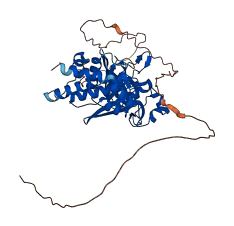A1L1L3
Gene name |
Ptpn20 |
Protein name |
Tyrosine-protein phosphatase non-receptor type 20 |
Names |
|
Species |
Rattus norvegicus (Rat) |
KEGG Pathway |
rno:306281 |
EC number |
3.1.3.48: Phosphoric monoester hydrolases |
Protein Class |
|

Descriptions
The autoinhibited protein was predicted that may have potential autoinhibitory elements via cis-regPred.
Autoinhibitory domains (AIDs)
Target domain |
|
Relief mechanism |
|
Assay |
cis-regPred |
Accessory elements
No accessory elements
Autoinhibited structure

Activated structure

1 structures for A1L1L3
| Entry ID | Method | Resolution | Chain | Position | Source |
|---|---|---|---|---|---|
| AF-A1L1L3-F1 | Predicted | AlphaFoldDB |
No variants for A1L1L3
| Variant ID(s) | Position | Change | Description | Diseaes Association | Provenance |
|---|---|---|---|---|---|
| No variants for A1L1L3 | |||||
No associated diseases with A1L1L3
4 regional properties for A1L1L3
| Type | Name | Position | InterPro Accession |
|---|---|---|---|
| domain | Tyrosine-specific protein phosphatase, PTPase domain | 159 - 415 | IPR000242 |
| domain | Tyrosine-specific protein phosphatases domain | 332 - 404 | IPR000387 |
| domain | Protein-tyrosine phosphatase, catalytic | 313 - 412 | IPR003595 |
| active_site | Protein-tyrosine phosphatase, active site | 352 - 362 | IPR016130 |
Functions
| Description | ||
|---|---|---|
| EC Number | 3.1.3.48 | Phosphoric monoester hydrolases |
| Subcellular Localization |
|
|
| PANTHER Family | ||
| PANTHER Subfamily | ||
| PANTHER Protein Class | ||
| PANTHER Pathway Category | No pathway information available | |
4 GO annotations of cellular component
| Name | Definition |
|---|---|
| cytoplasm | The contents of a cell excluding the plasma membrane and nucleus, but including other subcellular structures. |
| microtubule | Any of the long, generally straight, hollow tubes of internal diameter 12-15 nm and external diameter 24 nm found in a wide variety of eukaryotic cells; each consists (usually) of 13 protofilaments of polymeric tubulin, staggered in such a manner that the tubulin monomers are arranged in a helical pattern on the microtubular surface, and with the alpha/beta axes of the tubulin subunits parallel to the long axis of the tubule; exist in equilibrium with pool of tubulin monomers and can be rapidly assembled or disassembled in response to physiological stimuli; concerned with force generation, e.g. in the spindle. |
| microtubule organizing center | An intracellular structure that can catalyze gamma-tubulin-dependent microtubule nucleation and that can anchor microtubules by interacting with their minus ends, plus ends or sides. |
| nucleus | A membrane-bounded organelle of eukaryotic cells in which chromosomes are housed and replicated. In most cells, the nucleus contains all of the cell's chromosomes except the organellar chromosomes, and is the site of RNA synthesis and processing. In some species, or in specialized cell types, RNA metabolism or DNA replication may be absent. |
1 GO annotations of molecular function
| Name | Definition |
|---|---|
| protein tyrosine phosphatase activity | Catalysis of the reaction: protein tyrosine phosphate + H2O = protein tyrosine + phosphate. |
1 GO annotations of biological process
| Name | Definition |
|---|---|
| protein dephosphorylation | The process of removing one or more phosphoric residues from a protein. |
6 homologous proteins in AiPD
| UniProt AC | Gene Name | Protein Name | Species | Evidence Code |
|---|---|---|---|---|
| P17706 | PTPN2 | Tyrosine-protein phosphatase non-receptor type 2 | Homo sapiens (Human) | EV |
| P18031 | PTPN1 | Tyrosine-protein phosphatase non-receptor type 1 | Homo sapiens (Human) | PR |
| P35821 | Ptpn1 | Tyrosine-protein phosphatase non-receptor type 1 | Mus musculus (Mouse) | PR |
| Q06180 | Ptpn2 | Tyrosine-protein phosphatase non-receptor type 2 | Mus musculus (Mouse) | SS |
| P20417 | Ptpn1 | Tyrosine-protein phosphatase non-receptor type 1 | Rattus norvegicus (Rat) | PR |
| P35233 | Ptpn2 | Tyrosine-protein phosphatase non-receptor type 2 | Rattus norvegicus (Rat) | SS |
| 10 | 20 | 30 | 40 | 50 | 60 |
| MSSPGNVRQK | HGRDNDEHEG | DSDDLNLQKS | LPSSSQQKTP | TKPVFGNKVN | SESVKTSHHM |
| 70 | 80 | 90 | 100 | 110 | 120 |
| SFSNKYDLVF | PEPVESDNDE | TLWDVRDLSH | RNRWSSVDPE | SAGPSKTVST | VLSESSTDTA |
| 130 | 140 | 150 | 160 | 170 | 180 |
| VSERELTQLA | QIRPLIFNSS | SRAALRDCLK | ALQKKEELDI | IREFLELEEM | IPPDDFKSGY |
| 190 | 200 | 210 | 220 | 230 | 240 |
| ELQNRDKNRY | RDILPYDSTR | VPLGKNKDYI | NASYIRIVNH | EEEYFYIATQ | GPLPDTIEDF |
| 250 | 260 | 270 | 280 | 290 | 300 |
| WQMVLENNCN | VIAMITREIE | GGVIKCCSYW | PVSLKEPLEF | KHFHVLLENF | QITQYFVIRI |
| 310 | 320 | 330 | 340 | 350 | 360 |
| FQIVKKSTGK | SHSVKHLQFI | KWPDHGTPAS | ADFFIKYVRY | VRKSHITGPL | LVHCSAGVGR |
| 370 | 380 | 390 | 400 | 410 | 420 |
| TGVFICVDVV | FCTIEKNYSF | NIMNIVTQMR | KQRFGMIQTK | EQYQFCYEIV | LEVLQNLLAL |
| N |